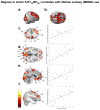Evidence for chronically altered serotonin function in the cerebral cortex of female 3,4-methylenedioxymethamphetamine polydrug users
- PMID: 22147810
- PMCID: PMC3538835
- DOI: 10.1001/archgenpsychiatry.2011.156
Evidence for chronically altered serotonin function in the cerebral cortex of female 3,4-methylenedioxymethamphetamine polydrug users
Abstract
Context: MDMA (3,4-methylenedioxymethamphetamine, also popularly known as "ecstasy") is a popular recreational drug that produces loss of serotonin axons in animal models. Whether MDMA produces chronic reductions in serotonin signaling in humans remains controversial.
Objective: To determine whether MDMA use is associated with chronic reductions in serotonin signaling in the cerebral cortex of women as reflected by increased serotonin(2A) receptor levels.
Design: Cross-sectional case-control study comparing serotonin(2A) receptor levels in abstinent female MDMA polydrug users with those in women who did not use MDMA (within-group design assessing the association of lifetime MDMA use and serotonin(2A) receptors). Case participants were abstinent from MDMA use for at least 90 days as verified by analysis of hair samples. The serotonin(2A) receptor levels in the cerebral cortex were determined using serotonin(2A)-specific positron emission tomography with radioligand fluorine 18-labeled setoperone as the tracer.
Setting: Academic medical center research laboratory.
Participants: A total of 14 female MDMA users and 10 women who did not use MDMA (controls). The main exclusion criteria were nondrug-related DSM-IV Axis I psychiatric disorders and general medical illness.
Main outcome measures: Cortical serotonin(2A) receptor nondisplaceable binding potential (serotonin(2A)BP(ND)).
Results: MDMA users had increased serotonin(2A)BP(ND) in occipital-parietal (19.7%), temporal (20.5%), occipitotemporal-parietal (18.3%), frontal (16.6%), and frontoparietal (18.5%) regions (corrected P < .05). Lifetime MDMA use was positively associated with serotonin(2A)BP(ND) in frontoparietal (β = 0.665; P = .007), occipitotemporal (β = 0.798; P = .002), frontolimbic (β = 0.634; P = .02), and frontal (β = 0.691; P = .008) regions. In contrast, there were no regions in which MDMA use was inversely associated with receptor levels. There were no statistically significant effects of the duration of MDMA abstinence on serotonin(2A)BP(ND).
Conclusions: The recreational use of MDMA is associated with long-lasting increases in serotonin(2A) receptor density. Serotonin(2A) receptor levels correlate positively with lifetime MDMA use and do not decrease with abstinence. These results suggest that MDMA use produces chronic serotonin neurotoxicity in humans. Given the broad role of serotonin in human brain function, the possibility for therapeutic MDMA use, and the widespread recreational popularity of this drug, these results have critical public health implications.
Figures


References
-
- Cowan RL. Neuroimaging research in human MDMA users: a review. Psychopharmacology (Berl) 2007;189(4):539–556. - PubMed
-
- Bankson MG, Cunningham KA. 3,4-Methylenedioxymethamphetamine (MDMA) as a unique model of serotonin receptor function and serotonin-dopamine interactions. J Pharmacol Exp Ther. 2001;297(3):846–852. - PubMed
-
- Substance Abuse and Mental Health Services Administration. The national survey on drug use and health (NSDUH) Substance Abuse and Mental Health Services Administration, Office of Applied Studies; 2008.
Publication types
MeSH terms
Substances
Grants and funding
- K01 MH083052/MH/NIMH NIH HHS/United States
- K12 DA00357/DA/NIDA NIH HHS/United States
- TL1 RR024978/RR/NCRR NIH HHS/United States
- KL2 RR024977/RR/NCRR NIH HHS/United States
- R01 DA01537/DA/NIDA NIH HHS/United States
- UL1 RR024975/RR/NCRR NIH HHS/United States
- R21 MH087803/MH/NIMH NIH HHS/United States
- R21 MH073800/MH/NIMH NIH HHS/United States
- R21 MH087803-02/MH/NIMH NIH HHS/United States
- R01 DA015137/DA/NIDA NIH HHS/United States
- K12 DA000357/DA/NIDA NIH HHS/United States
- R21 DA020149/DA/NIDA NIH HHS/United States
LinkOut - more resources
Full Text Sources
Medical

